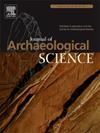Dentin collagen sample geometry impacts pattern of intra-tooth nitrogen and carbon isotope change in taurine teeth
IF 2.6
1区 地球科学
Q1 ANTHROPOLOGY
引用次数: 0
Abstract
Sequential stable isotope analyses of hypsodont ruminant molars provide insights into animal behavior and human-animal interactions at seasonal scales. Stable carbon (δ13C) and nitrogen (δ15N) isotope ratios obtained from intra-tooth sequences of dentinal collagen inform on animal weaning and feeding habits, but sequential sampling of this tissue is rarely carried out in part due to the undefined relationship between dentin geometry, sample position, and measured isotope values. Here, we present a serial sampling approach applied to dentin collagen from modern and archaeological taurine second molars that entails sub-sampling the outermost portion of the dentin structure. Compared to intra-tooth isotope sequences measured from the entire thickness of the dentin structure, nitrogen isotope sequences obtained from the outermost dentin portion better capture the weaning process, while carbon isotope values reveal subtle but discernible shifts in C3 dietary intake that were not visible in dentin portions involving the entire dentin thickness. The ability to document dietary change at higher resolution has important implications for gaining more nuanced insights into livestock husbandry practices in the past, including foddering, weaning, and pasturing.
牙本质胶原蛋白样品几何形状对牛磺酸牙内氮碳同位素变化模式的影响
对下齿反刍动物臼齿的连续稳定同位素分析提供了在季节尺度上动物行为和人-动物相互作用的见解。从牙本质胶原的牙内序列中获得稳定的碳(δ13C)和氮(δ15N)同位素比率,这为动物断奶和摄食习惯提供了信息,但由于牙本质几何形状、样品位置和测量的同位素值之间的关系不明确,很少对该组织进行顺序采样。在这里,我们提出了一种适用于现代和考古牛磺酸第二磨牙的牙本质胶原蛋白的连续采样方法,该方法需要对牙本质结构的最外层进行亚采样。与从牙本质结构的整个厚度测量的牙内同位素序列相比,从最外层牙本质部分获得的氮同位素序列更好地捕捉了断奶过程,而碳同位素值显示了细微但可识别的C3饮食摄入量的变化,而在涉及整个牙本质厚度的牙本质部分则不可见。以更高分辨率记录饮食变化的能力对于获得对过去畜牧业实践(包括饲料、断奶和放牧)更细致入微的了解具有重要意义。
本文章由计算机程序翻译,如有差异,请以英文原文为准。
求助全文
约1分钟内获得全文
求助全文
来源期刊

Journal of Archaeological Science
地学-地球科学综合
CiteScore
6.10
自引率
7.10%
发文量
112
审稿时长
49 days
期刊介绍:
The Journal of Archaeological Science is aimed at archaeologists and scientists with particular interests in advancing the development and application of scientific techniques and methodologies to all areas of archaeology. This established monthly journal publishes focus articles, original research papers and major review articles, of wide archaeological significance. The journal provides an international forum for archaeologists and scientists from widely different scientific backgrounds who share a common interest in developing and applying scientific methods to inform major debates through improving the quality and reliability of scientific information derived from archaeological research.
 求助内容:
求助内容: 应助结果提醒方式:
应助结果提醒方式:


